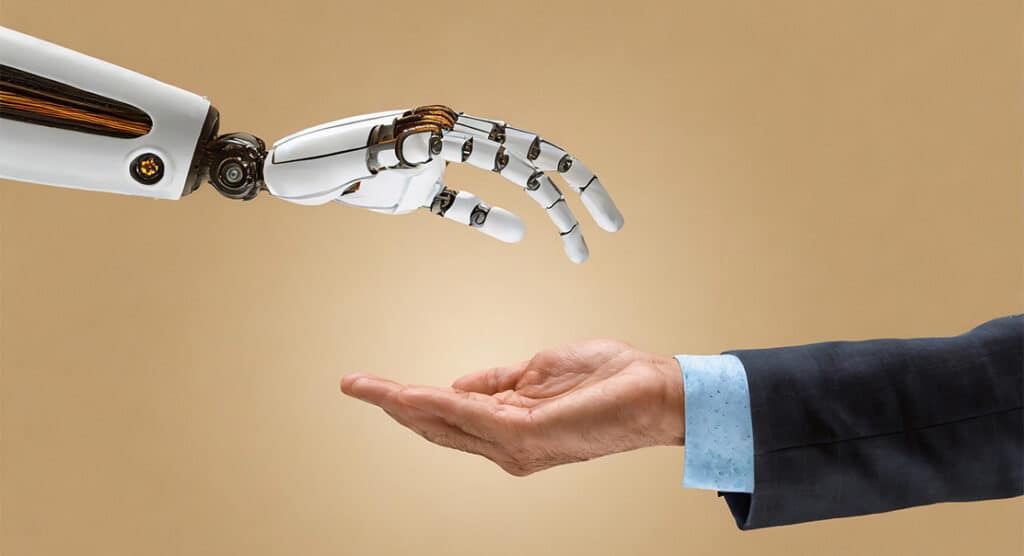Made in His image: Implications for our use of AI
This article was first published in the Social Issues Bulletin – Issue 54: Winter 2023.
Parts of this article are based on extracts from J. Peckham, Masters or Slaves? AI and the Future of Humanity, IVP, 2021, pp 43-65, used with kind permission from IVP.

A Christian anthropology
In our last article, we considered the rapid advances in so called Artificial Intelligence, particularly Generative AI applications like ChatGPT, and how the deployment of various applications might impact us as individuals and society at large.1 We observed that most people, including the developers of such technology, have a tendency to use anthropomorphic terms when describing the capabilities of AI. In so doing we ascribe human characteristics, such as intelligence and thinking, to artefacts that are in fact no more than ‘black boxes’ that use sophisticated statistical pattern matching techniques.
If we are to be able to evaluate such technology and its impact on humanity and the church, our starting point must be a uniquely Christian anthropology. In this article we will explore the dimensions of such an anthropology, located in God’s unique revelation to us in the Bible.
Right from the opening chapter of the Bible we learn that we’re created in God’s image when God said:
Let us make man in our image, after our likeness. And let them have dominion over the fish of the sea and over the birds of the heavens and over the livestock and over all the earth and over every creeping thing that creeps on the earth. (Genesis 1:26)
In God’s creating activity, man and woman are singled out from the animals and the rest of physical creation as special, because nowhere else in Scripture is anything else that God creates defined as in his ‘image’ or ‘likeness’. But what does it really mean to be made in his image or likeness? To get to grips with this, we need to understand something about the essence of God.
The essence of God
God does not manifest himself in physical form: he’s metaphysical and this therefore means that in some way we mirror his essence or nature, both through our body and what we call the soul. This is often referred to as the ontological view of Imago Dei.
The church fathers were the first to study more thoroughly what Imago Dei (image of God) means, and Tertullian saw free will as the essential mark or stamp of the divine image. Augustine suggested that God and humans share some ontological2 component, trait or quality that essentially defines us: memory, intelligence and will.
Varying views were held among the Reformers and Reformed theologians, but the dominant view has been that there’s both a narrow and a broad definition of what it means to be made in God’s image. The narrow definition describes a spiritual dimension, or the virtues of holiness, knowledge of the truth and righteousness that humans possessed before the fall. In the narrow definition this divine image was lost in the fall of humankind and could be reclaimed only through redemption. However, a broader view of Imago Dei accepts that humans possess other attributes of God, such as intelligence, natural affection and freedom to choose, and that these are retained by all of humanity.3
What is clear is that even after the Fall, God still speaks of humankind as ‘made in his own image’, there is no hint that it has been destroyed by the Fall (Genesis 9:6).
Some theologians like to group the attributes of God into categories such as goodness – embracing attributes such as love, mercy, righteousness, justice and holiness. The category of knowledge covers the attributes of speech, reason, truth and wisdom. God’s power is yet another category that covers his eternal being, existence, omnipresence and immensity.4 Clearly, these are not attributes of humankind. All of these attributes are of course part and parcel of who God is, and any divisions are merely human attempts to try to define what he’s like. What we can say overall is that these attributes encompass God’s moral excellence.
The attribute of truth is worth a small excursus as it has important implications for our thinking about AI technology, especially Generative AI.
Truth and reality
The Hebrew root ‘emet is used in various ways in the OT in terms related to truth and conveys the ideas of stability, support, faithfulness and conformity to fact. God, speaking through the prophet Isaiah declares ‘I the Lord speak the truth; I declare what is right’ (Isa 45:19). The word is also used to convey the idea of conformity to reality as opposed to something erroneous as for example the response of witnesses in Isaiah 45:9 ‘Let them bring their witnesses to prove them right, and let them hear and say, it is true’. There is a harmony between the different usages of these terms, as Roger Nicole puts it:
It is because truth is conformity to fact that confidence may be placed in it or in the one who asserts it, and it is because a person is faithful that he or she will be careful to make statements that are true.5
The NT usage of the term for truth accords with these OT concepts and also implies the absoluteness of truth, such as when Jesus prays for his disciples, ‘Sanctify them in the truth; your word is truth’ (John 17:17).
The idea that truth is conformity to reality is referred to as the correspondence view of truth and is key to our thinking about what is actually output by the Large Language Models (LLMs) of Generative AI applications like ChatGPT. These systems generally don’t output specific quotes from individuals but produce a natural language synthesis from the training text corpora, raising the question, ‘how do we know it’s true’. We cannot attribute the output to a specific person or text. If we were to use the Bible texts as an example, simply outputting an amalgam of such texts, albeit in plausible natural language responses to questions posed, would be a distortion of God’s revelation to us that has been carefully preserved over centuries.
It is also worth noting that language is the means by which God reveals himself and truth (his word) to us. The emulation of natural language by an artefact, such as ChatGPT, that purports to be the same as that spoken or written by a person should raise serious ethical concerns for Christians who are called to mirror the Biblical correspondence meaning of truth. This understanding should also cause us to reflect carefully on whether such tools can be used in the Great Commission without compromising this calling. As the Apostle Paul writes to the Ephesian Christians, ‘having put away falsehood, let each one of you speak the truth with his neighbour,’ (Eph 4:25). In using the likes of ChatGPT we must be careful to avoid what the prophet Isaiah laments, that ’truth has stumbled in the public squares’ (Isa 59:14).
Moral agency
When God made Adam and Eve he gave them freedom to choose – moral freedom. They chose, against God’s command, to eat the fruit of the tree of the knowledge of good and evil when they were tempted in the Garden of Eden. This choice ended with disastrous consequences for creation and humankind.
Some have however challenged this notion of free will, a concept that the author Yuval Harari sees as existing ‘only in the imaginary stories we humans have invented’. Harari justifies this perspective on the basis that:
Over the last century, as scientists opened up the Sapiens black box, they discovered there neither soul, nor free will, nor ‘self’ – but only genes, hormones and neurons that obey the same physical and chemical laws governing the rest of reality.6
Free will however is foundational to moral responsibility, regardless of whether one thinks morality has external agency or not. As a concept it’s therefore important in the debate about AI potentialities, as well as in framing ethical questions in the use of AI and our relationship to it. It’s also important in relation to the moral responsibility at the heart of the ethical debate about self-driving vehicles and autonomous weapons. Effectively, when we step into a self-driving taxi or our own self-driving vehicle, we’re handing over moral agency to that vehicle.
Let us reason together
Turning to the category of knowledge as an attribute of God, we see that he’s a reasoning, logical and intelligent God who is truth itself. We see that God is a reasoning God in Isaiah’s vision concerning Judah and Jerusalem, where he communicates his view of the waywardness of his people. God nonetheless encourages them to repentance and forgiveness with the words ‘Come now, let us reason together, says the Lord’ (Isa 1:18).
Our ability to reason is a precious part of what it means to be human. It’s special to us and we don’t see it mirrored in animals. This ability to reason is communicated in language, both spoken and written, at a level unique to humans. We see reason worked out in Adam’s relationship and communion with God, in his understanding of what God was telling him and acting upon it – such as in naming the animals that God brought before him.
This is why we must be careful how we think about Generative AI and avoid anthropomorphising it and imagining that it reasons and thinks like a human, that it is a human created intelligence that might even surpass ours.
Another aspect of the nature of God is that the act of creation itself shows us that he’s a God who works and creates. Work was also part of God’s design for humankind and clearly a part of the natural order when he created Adam and Eve and they tilled and kept the garden.
Clearly the fall of humankind, described in Genesis 3, changes what we’re like because of the introduction of the corrupting power of sin. No longer do we love perfectly or think completely rationally, and no longer do we seek justice and righteousness as God does, because of our selfish desires. Nonetheless, we remain creatures made in his image, made of his essence, and some of the nature of God is still seen, even in fallen humankind.
This image begins to be restored when we’re redeemed by Christ, as Paul reminds the Colossian Christians when he tells them that they’re to be renewed after the image of their creator (Col 3:10).
What we’ve seen so far is that Imago Dei means being made as a mirror of the nature of God. This has to do with reflecting some of God’s attributes, such as being moral, and having freedom to choose and to reason.
Ambassadors of God
In the twentieth century, theologians began to challenge the ontological view, or what we might call ‘the attributes of God’, as what’s meant by being created in his image. They argued that Imago Dei is more about the function of humans, what we’re made to do, rather than what we are or what attributes we display. This view sees humankind as agents or representatives of God rather than sharing his attributes. For convenience, I’ve called this the functional view. This view, however, is really more about what we do as people made in God’s likeness, and in my view it would be a mistake to see it as an alternative meaning of Imago Dei. It does not replace the understanding that we’ve so far explored of what being made in his image or likeness means.
Rather, as we shall see, it complements the ontological view and provides the impetus for reflecting God’s image and lays a responsibility on us to do so.
The functional role rests on an alternative translation of Genesis 1:26, ‘let us make humanity as our image’,7 but it’s also supported by the second part of Genesis 1:26, where God says, ‘And let them have dominion’. This verse is essentially saying that humans are to have dominion over all that he has created, whether living or non-living. This view of Imago Dei is one of humankind being delegated by God to oversee his creation as his vicegerent.8
The idea of being a vicegerent comes from the ancient rule of kings over their kingdom and people, with the vicegerent being appointed to co-govern or rule. In ancient times a king might have had statues (icons) erected to remind his subjects who was king and lord over them. In ancient Egyptian and Mesopotamian texts kings were seen as sons of gods and therefore being in the god’s image. This is an interesting motif when we consider the biblical texts that also speak of Adam’s being a ‘son of God’ (Luke 3:38). Being in God’s image carries with it the idea of sonship and sons representing our Father on earth in his cosmic temple.
This idea of image bearing or of being ‘icons’ of God in his creation is a powerful one, especially in the context of thinking about ways our image bearing might be tarnished by the use of AI technology.
The functional view of being made in God’s image goes beyond the idea of being an icon, something that should look like the one it represents. To exercise dominion over God’s creation is not a passive thing. It carries with it the responsibility to work and be creative: we see that even before the fall God put humans in a garden to till and keep it: ‘The Lord God took the man and put him in the garden of Eden to work it and keep it’ (Gen 2:15).
The functional view of Imago Dei emphasises the purpose for which we’re made: humanity’s function. Rather than standing opposed to the ontological view that we share some of the attributes of God, it underscores our need to ensure that we reflect those attributes, that image. The icon bears witness to the one whom it represents. Going further, the vicegerent has a responsibility to function in a way consistent with the nature of our creator, whose image we bear.
We must therefore be careful not to allow our humanity to be ‘downgraded’. Ex-Google ethicist Tristan Harris has popularised this term to describe the way in which smartphones affect humanity. Harris cites a number of ways in which humanity is being dumbed down by technology designed to grab more and more of our attention. This results in an interconnected set of issues such as shortening attention spans, social isolation, and polarisation of views along with manipulation and addiction, brought about by the use of techniques such as notifications (for example when a text message arrives).
Made for relationship
One of the consequences of God being moral in character is his unconditional love, a love that has meaning only because he has the freedom to choose to love. This love is shown supremely in God’s love for fallen humans in sending his Son, Jesus Christ, to suffer and die for our sins. We too share the ability to love, because we’re made in his image.
Although there was love and communion between God and Adam, God desired that man should have a human companion, so he brought forth woman from Adam’s rib. They were able to enjoy love for each other and intimacy as one flesh. True love stems from God’s moral nature and requires freedom to choose to love, or it’s not love at all.
Proponents of the relational view of Imago Dei see the significance in the use of the plural in Genesis 1:26, ’let us make man in our image’ and suggest that this means image is the relationship within the ‘us’ and ‘our’, although there is debate over who is referred to. There is no doubt however that God the Father, Son and Holy Spirit are involved in creation and are in relationship. Humans were clearly created for relationship, ultimately to love and obey God; and if we’re a Christian, this becomes the main goal in our lives, along with loving our neighbour as ourselves. This is born out in Jesus’ answer to the scribe who asked Him what the most important commands were:
And you shall love the Lord your God with all your heart and with all your soul and with all your mind and with all your strength.’ The second is this: ‘You shall love your neighbour as yourself.’ (Mark 12:30–31)
The relationship aspect of Imago Dei helps us to think about whether my use of AI technology might affect the way in which I relate to people – does it diminish authentic, embodied soul-to-soul relationships with others and, of course, ultimately my relationship with God? Various studies have shown how the manipulative algorithms in social media platforms have impacted the digital generation’s relationships and attitudes.
A holistic view of Imago Dei embraces the ontological, functional and relational dimensions and provides the foundation for the development of Christian ethics in regard to AI and its uses.
Before we conclude, it is worth exploring a little further where the image of God in us resides. In essence, the question that we need to address comes down to this – does the body have a soul? How we answer this question is likely to determine what we think about the prospects for creating artificial general intelligence (AGI) and beyond this super intelligence. Putting it another way, is the essence of what it means to be human something special, something metaphysical, or is it merely physical, an evolution of our brains?
More than matter
Some would see our brains as simply a computer made up of cells, rather than silicon chips, that has evolved over time to develop capabilities such as reasoning, moral choice and love. Indeed, the most advanced AI systems are built on mathematical models called neural networks inspired by how the brain works. Some.
The Hebrew word nepeš, translated ‘soul’, occurs over 780 times in the Old Testament. Although often meaning simply the essence of life or the act of breathing, the Hebrew system of thought does not distinguish between ‘body’ and ‘soul’. It’s best viewed as the inner self, as opposed to the outward appearance. In this sense, then, the soul is the real me, and part of this notion is also the idea that it’s the soul that is conscious and enables me to know that I am me.
The precise manner in which God gave us a soul or consciousness is less important than the fact that he did. Christians have traditionally argued for a substance dualism view from the early church fathers, with the consequence that the soul is understood as a metaphysical part that lives forever and will be reunited with the body when we’re resurrected.
Scientific naturalism avoids any explanation that would allow or require a supernatural or metaphysical dimension, as would be the case in substance dualism. It proposes the idea that consciousness, or the ‘soul’ of man, emerges from the firing of the neurons in our brain as a child develops and is exposed to its environment (monism).
A monistic view of the soul is problematic in that it’s inevitably reductionist and does not allow an explanation of how a ‘higher’ level emergent consciousness can control the physical components from which the soul itself is supposedly derived.
While a pure monism view of the soul or consciousness might be rejected by Christians, some favour a hybrid view or a body–soul duality that tries to avoid the inevitable reductionism of pure monism. This idea comes in varying forms but one view expressed by John Polkinghorne is that ‘the pattern that is my soul develops as my character forms and my experiences, understanding and decisions mould the kind of person that I am’. He argues that ‘this way of understanding the soul implies that it does not of itself possess an intrinsic immortality’ but that it dissolves at death with God memorising it so that is is rejoined to the physical body at our resurrection.9
What’s clear is that we’re still some way from being able to explain the soul and consciousness in any more coherent way than did the early church fathers. Perhaps that’s because it’s impossible to define the metaphysical in terms that we can grasp, even with the notion Polkinghorne uses, that God can memorise the neuronal pattern that is me.10 This should not surprise us, because in our endeavour to rationalize everything we can be in danger of losing the mystical or unfathomable.
None of these speculations or proposed explanations for the soul takes away from the reality for the Christian that personhood entails being made in God’s image, and that this is part of the inner self, the soul or consciousness.
Those who tend to a substance-dualism view will likely find it easier to believe that we can never develop a truly general AI, let alone a superintelligence, because we cannot define it in order to encode it. A naturalist, or perhaps someone who believes that the soul emerges over time, may find it perfectly reasonable to believe that it’s only a matter of time before we can create a self-learning algorithm capable of simulating the emergent soul and becoming conscious.
Although it’s not necessary here to delve further into the philosophical arguments for or against both viewpoints, it’s important for us to understand that many of those working in the field of AI, AI ethics and policy formation will tend to a scientific naturalism world view.11 This will shape their ethics, their view of what AI is and indeed whether there is the possibility of creating a general AI or even super intelligence.
Conclusion
Drawing these various threads together, we’ve learnt that we’re made in God’s likeness and therefore bear something of his nature, albeit tarnished by sin. This nature can be described by a number of attributes that include moral freedom, from which love, justice and righteousness flow, and an ability to reason. All these attributes are unique to humanity and distinguish us from animal life.
We saw also that God commissioned humanity to be stewards over his creation and made us his representatives, his vicegerents. As God’s redeemed people we are to be salt and light, his ambassadors, given responsibility to show the world God’s character. We are to image him in the world through who we are and how we act. God also made us to work in his creation and even though it’s made more difficult by the fall, there’s dignity in work.
Finally, being made in the likeness of the triune God who shows us unconditional love, is to be made for a loving relationship with him and with our fellow humans.
Many of the challenges that we face in developing and deploying AI-based systems have to do with how they potentially influence what it means to be human, and how they affect our image-bearing. Whenever our mirroring of the image of God in us is diminished, it’s an affront to God, and if we’re distracted from putting on Christ, then we negatively influence our image bearing and being vicegerents. If we truly believe that we’re created in his image, then great care is required in how we use and develop AI systems.
In our next article, we will explore how this foundation of Christian anthropology we have developed here can be applied in some specific use cases of AI.
1 See: Affinity’s Social Issues Bulletin – Issue 53. Online: https://www.affinity.org.uk/app/uploads/2023/08/Issue-53-Summer-2023_final-WEB.pdf
2 The essence or nature of being.
3 L. Berkhof, Systematic Theology (Edinburgh: Banner of Truth Trust, 1976), p. 204.
4 J. Frame, The Doctrine of God (Phillipsburg, N.J.: P&R Publishing, 2002), p. 399.
5 Roger Nicole, ‘The Biblical Concept of Truth’, Scripture and Truth, ed. D.A. Carson, John D. Woodbridge (Grand Rapids, MI: Zondervan Publishing House, 1983), 291.
6 Y. N. Harari, Homo Deus: A Brief History of Tomorrow (London: Harvill Secker, 2016), p. 329.
7 T. D. Alexander and D. W. Baker, Dictionary of the Old Testament, Pentateuch (Downers Grove: InterVarsity Press; Leicester: Inter-Varsity Press, 2003), pp. 443–444.
8 For an extended treatment of this view see J. R. Middleton, The Liberating Image: The Imago Dei in Genesis 1 (Grand Rapids: Brazos Press, 2005).
9 See: J. Polkinghorne, Exploring Reality (London: SPCK, 2005), p. 44,49.
10 Ibid. p 49
11 For an analysis of the two views see J. P. Morland, ‘Searle’s Biological Naturalism and the Argument from Consciousness’, Faith and Philosophy 15 (1998), pp. 68–90.

Stay connected with our monthly update
Sign up to receive the latest news from Affinity and our members, delivered straight to your inbox once a month.



